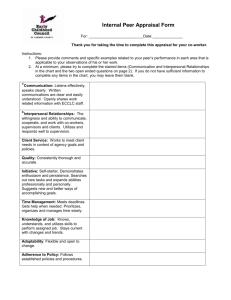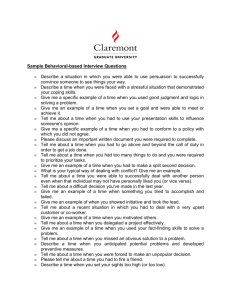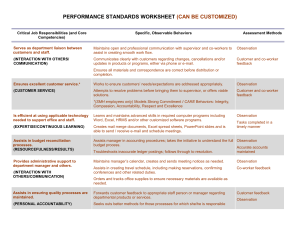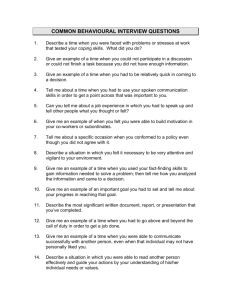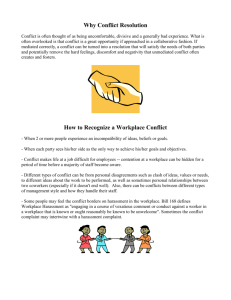- Sunway Institutional Repository
advertisement
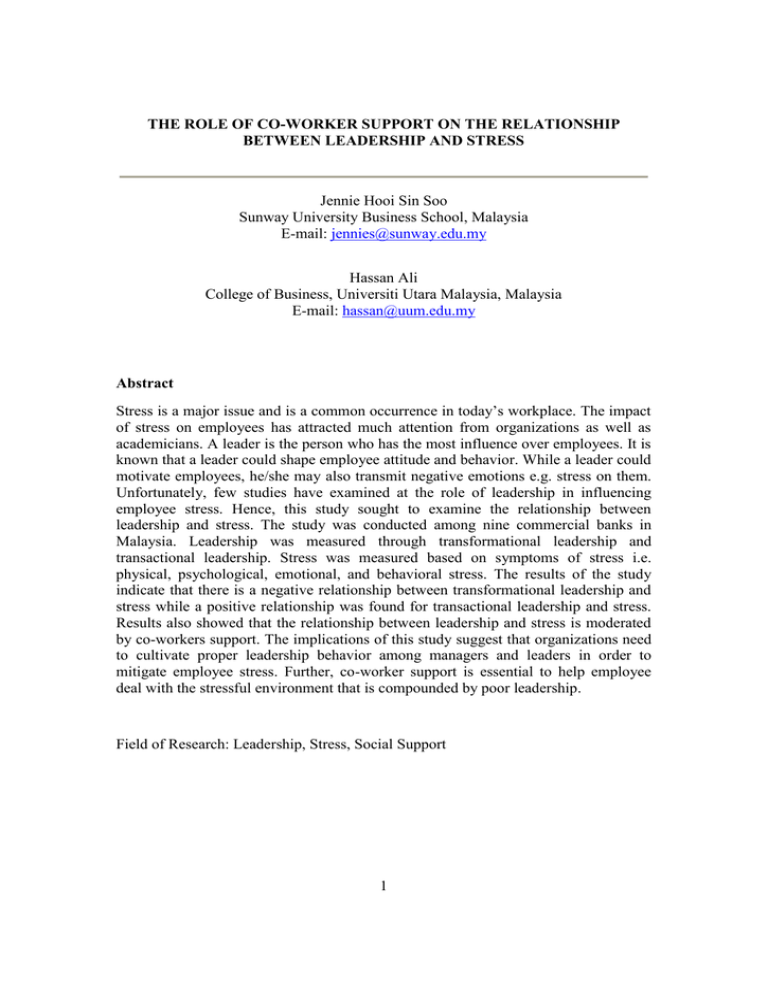
THE ROLE OF CO-WORKER SUPPORT ON THE RELATIONSHIP BETWEEN LEADERSHIP AND STRESS Jennie Hooi Sin Soo Sunway University Business School, Malaysia E-mail: jennies@sunway.edu.my Hassan Ali College of Business, Universiti Utara Malaysia, Malaysia E-mail: hassan@uum.edu.my Abstract Stress is a major issue and is a common occurrence in today’s workplace. The impact of stress on employees has attracted much attention from organizations as well as academicians. A leader is the person who has the most influence over employees. It is known that a leader could shape employee attitude and behavior. While a leader could motivate employees, he/she may also transmit negative emotions e.g. stress on them. Unfortunately, few studies have examined at the role of leadership in influencing employee stress. Hence, this study sought to examine the relationship between leadership and stress. The study was conducted among nine commercial banks in Malaysia. Leadership was measured through transformational leadership and transactional leadership. Stress was measured based on symptoms of stress i.e. physical, psychological, emotional, and behavioral stress. The results of the study indicate that there is a negative relationship between transformational leadership and stress while a positive relationship was found for transactional leadership and stress. Results also showed that the relationship between leadership and stress is moderated by co-workers support. The implications of this study suggest that organizations need to cultivate proper leadership behavior among managers and leaders in order to mitigate employee stress. Further, co-worker support is essential to help employee deal with the stressful environment that is compounded by poor leadership. Field of Research: Leadership, Stress, Social Support 1 Introduction The world today is certainly facing great economic challenges and many organizations are under intense economic pressure. The economic challenges and demands pressure organizations to change through reorganizations, joint ventures, mergers or downsizings in order to survive, consequently employees have to deal with uncertainty and anxiety in workplace. There is no surprise that employee complaining they are stressed as stress is a worldwide epidemic in today’s work environment. Paul J. Rosch, the President of the American Institute of Stress (AIS) (2009), has commented that stress occurs as a result of workplace pressure, and reported that 28% of workers complained that their job is extremely stressful. American Psychological Association (2010) found that about 70% of Americans admitted they are stressed due to their work. In addition, another survey conducted in Canada by Statistic Canada (2006) showed that around 38.8% of employees are slightly stressed at work; 25% are relatively stressed at workplace while 5.4% of employees are extremely stressed. Despite the worldwide facts and statistics, there are several academic research conducted to examine the issue of stress. Neelamegam and Asrafi (2010) found that 44.6% of workers admitted that stress is becoming a major problem in their daily work. Newstrom and Davis (2002) stated that 46% of workers viewed their job as extremely stressful and about 34% of workers believed they will experience burnout in the workplace. Around 83% of human resource managers claimed that stress is a major problem in their organizations (McShane & Glinow, 2000). There is no room for Malaysia to escape from this issue. Malaysian Psychiatric Association (2007) reported that 6 out of 10 people suffered from stress. A study conducted by Yin-Fah, Foon, Chee-Leong and Osman (2010) found that 50% of private sector employees experience high level of stress. In addition, Salleh, Bakar and Keong (2008) reported that 35.9% of workers claimed that their job is stressful. Hence, stress is a serious issue and urgently needed attention in order to reduce its deleterious effect in Malaysia. Stress commonly refers as the feelings of worry, depression, anxiety, tense, and nervousness in normal daily life. Specifically, stress is a physiological or psychological response to the interaction of external environment and people (Gibson, Ivancevich, Donnelly, & Konopaske, 2009). If individual found that environmental hassles and demands are exceeding his/her ability, their stress will emerge (Montgomery & Rupp, 2005). Stress may happened in another situation especially when individual involved in the human interaction (Beehr & Newman, 1978) with people in social environment e.g. their leader, their friends, their customers. Stress may also incurred in the interaction when individual’s resources loss such as effort and time contributed in performing their job is greater than the resources gain i.e. support or appraisal gained from the leader (e.g. Hobfoll, 1989). Stress tends to be more pervasive and persistent nowadays because it primarily stems from individual’s psychological threats. However, difference individuals will display different symptoms of stress as various symptoms of stress are deferring from each individuals. 2 Having a little amount of stress is useful for employees to call up resources to respond to given challenges, as a result, employees are encouraged and motivated to perform at an even higher level of performance. However, having excessive amount of stress could negatively affect employees as well as employer. The negative effects of stress on organization results in reduce work quality; lower commitment; increase turnover; decreased in productivity, performance declined; and decreased in organizational effectiveness. Several studies (eg. Barhem, Sidin, Abdullah, & Alsagoff, 2004; Biswas & Biswas, 2010; Cropanzano, Rupp, & Byrne, 2003) found that employees who experience stress would likely decrease the quality of work in organization, and have less commitment to the organization, and thus cause a decline in organizational productivity. Workplace productivity found to decrease 7.6% due to depression (Hemp, 2004) and 69% of workers claim that they are become less productive due to health problem caused by stress (Newstrom & Davis, 2002). Karatepe and Uludag (2008) found that stress have an inverse relationship to job performance. Newstrom and Davis (2002) found performance significantly reduced when employees suffer from high levels of stress. Furthermore stress employees are not willing to exhibit extra-role behaviors such as organizational citizenship behavior (eg. Chui & Tsai, 2006; Halbesleben & Bowler, 2007). In addition, highly stressed employees have high tendency to leave the organization where stress is found positively related to turnover intention (Yin-Fah et al., 2010). Further, Ahsan, Abdullah, Fie, and Alam (2009) found that job stress were negatively affect satisfaction among academician in public university in Malaysia. In view of stress has deleterious effects on organization, it is an inevitable responsibility for organizations to prevent or mitigate employee’s stress in workplace. Leaders is the best person who can put a curb on employee stress (Cheng-min & Borwen, 2009) because leaders have the ability to influence employee’s emotion (Bass, 1985; Burns, 1978). Leaders can help in reduce employees stress if the leader empower to followers, align followers’ activities towards goals attainment, help followers deal with personal issues and induce positive emotion on followers. Although leadership behavior substantially play a role in mitigating stress, but it sometimes can generate stress on employees (Seltzer & Numerof, 1988; Strodeur, D'hoore, & Vandenberghe, 2001). For example, leaders who are closely monitors on employees, continuously gives directions and instructions, continually places high performance expectations and is too control-oriented can increase employee stress (Strodeur et al., 2001). Unfortunately leaders usually underestimate and are not aware that their leadership behavior could cause employee stress (Offermann & Hellmann, 1996; Strodeur et al., 2001). The impact of leadership on employee stress has received very little research attention. There is a dearth of studies that examine the influence of leadership on employee stress (Offermann & Hellmann, 1996; Sosik & Godshalk, 2000). A study conducted by Offermann and Hellmann (1996) asserted that leaders may not notice that their behavior can attribute to employee stress. The study was collected data from 343 mid-level managers in a multinational bank in Washington. Managers were required to complete the survey questionnaire themselves and were also requested their bosses and subordinate to answer the questionnaire. The findings indicated that 3 leadership behaviors were related to the manager’s stress. Specifically, the manager’s stress was higher when their leaders are less participative, less delegate, less communicate and have high level of control and goal pressure. Another study examined transformational and transactional leadership with job-related stress by Sosik and Godshalk (2000) was conducted at a public university in the Northeast of U.S. The study had 204 master’s students as respondents. The study found that only transformational leadership has a negative relationship to job-related stress however the study failed to find any relationship between transactional leadership and jobrelated stress. Although it is postulated that leadership might generate employees’ stress, however with the adequate amount of social support, employees’ stress can be diminished. Social support is viewed as one of the most effective ways in coping with stress (Gibson et al., 2009; Shen, 2009) because social support has buffering effect on stress. Employees who obtained a high level of social support might view the stressful environment as less stressful (Luszczynska & Cieslak, 2005) because high level of support will let employees feel more secure and safer and employees have more vigor in confront on stress. Luszczynska and Cieslak (2005) utilized four sources of social support i.e. supervisors support, co-workers support, family support and friends support to examine the effects of social support on work stress. The study found that supervisor support reduced employees work strain, while co-workers and family support buffered the effects of work stress. In addition, Calvete and Connor-Smith (2006) and Toro, Tulloch, and Ouellete (2008) also found a consistent result whereby social support is found to be buffering stress. Their study is used three sources of social support namely family support; friends support and support from significant others. Previous studies examined the direct effect of social support on stress. However there is no single study that examined the indirect effect of social support on the relationship between leadership and stress. Parasuraman, Greenhaus and Granrose (1992) argued that social support may buffer or moderate the relationships of different stressors and it was further supported by Bowling et al. (2004) who indicated that stressor-strain relationship is moderated by social support. In consideration of social support widely accepted to mitigate stress, this study includes co-worker support as a moderator variable in the relationship between leadership and stress. Method The study was carried out within a sample of employees drawn from nine commercial banks in Malaysia. All the full-time bank employees were involved in the study. Questionnaire was translated into Bahasa Melayu based on back translation procedure (Brislin, 1970) to make respondent easier to understand on the measurement items. A questionnaire with the cover letter explaining the purpose of the study and assurance on the anonymity of responses was sent to bank manager. Bank manager then 4 distributed the questionnaires to their employees. Questionnaires were collected after two weeks by self-administrated approach. Out of 799 questionnaires distributed to banks’ employees, only 474 usable questionnaires were returned, which gave a response rate of 59.3%. The respondents comprised of 184 (39%) males and 290 (61%) females. Thirty eight percent of the respondents were below 30 years, forty one percent were between 31-40 years, and nineteen percent were over 40 years old. Most of the respondents (61%) were married. The average experience of respondents was 9 years (SD=7 years). Most of the respondents (74%) had worked with their current leader more than one year and fewer than 6% had worked with their current leader less than 6 months. The measurement stress were adapted from several surveys (e.g. Health and safety stress questionnaire, 2003; Layne, 2001; Pejtersen & Kristensen, 2004; UCU model stress questionnaire, 2010) to incorporate symptoms of stress namely physical stress and emotional stress. Each stress symptoms were measured by five items. All the 10 items were measured based on frequency of occurrence on stress symptoms. Respondents rated how often they experienced stress in the past three months on a 4point rating scale ranging from 1 = never, 2 = sometimes, 3 = often, 4 = always. Two types of leadership i.e. transformational leadership and transactional leadership were adapted from Multifactor Leadership Questionnaire (MLQ Form 5xshort) developed by Bass & Avolio (1995). Nineteen items used to measured transformational leadership while twelve items used to measured transactional leadership. A 5-point response scale ranging from 1 (not at all) to 5 (frequently, if not always) was used for all items. Higher scores on transformational leadership indicated the leaders are charisma and emphasizes on the relationship with employees whereas higher score on transactional leadership indicated the leader is autocratic and taskoriented. Transformational leadership dimensions included idealized influence, inspiration motivation, intellectual stimulation, and individual consideration. Three dimensions defined transactional leadership included contingent rewards, active management-by-exception, and passive management-by-exception. Co-worker support was adapted from several surveys (Kim, Price, Mueller, & Watson, 1996; Zimmer, Dahlem, Zimet, & Farley, 1988). Only items that are related to co-worker support were adapted in this study. Co-worker support was measured by four items. All the items were rated using a 4-point Likert scale with 1 = strongly disagree to 4 = strongly agree. A higher score indicated employees received strong support from their co-workers. A factor analysis that utilized a principal component analysis with varimax rotation (Hair, Anderson, Tatham, & Black, 1998) was performed in order to ensure the validity of the items measurement and the underlying dimensions for each construct. All the items are analyzed based on the criteria item loading above 0.50 and the cross loading items should not higher than 0.35 (Igbaria, Iivari, & Maragahh, 1995). All reliabilities are above the 0.70 as indicated by Nunnally (1978). Hierarchical multiple regression was performed to test the moderating effect of social support on the relationship between leadership and stress. The used of 5 hierarchical regression analysis because it is the most useful analysis to detect the moderating effect (Aiken & West, 1991). Several steps were involved in the hierarchical regression analysis. First, leadership dimensions were entered into the regression equation as independent variables with physical stress as dependent variable. Following the moderator variable, co-worker support was entered into second equation as independent variables, and thirdly the interaction between leadership dimensions and co-worker support were entered into third equation as independent variables with physical stress as dependent variable. In order to get the moderating effect on emotional stress, all the three steps above were repeated again while the dependent variable has changed to psychological stress, emotional stress and behavioral stress respectively. Results Two moderating effects were found for co-worker support. First, the moderating effect of co-worker support was found between passive management-by-exception and physical stress, and second, the relationship between inspiration motivation and emotional stress was found to be moderated by co-worker support. The results of hierarchical regression analyses are presented at Table 1 and 2 (refer to Appendix 1 and 2). Table 1 shows the results of the hierarchical regression analysis with the physical stress is dependent variable. Individual consideration (β = -0.26, p < 0.01), active management-by-exception (β = 0.13, p < 0.01) and passive management byexception (β = 0.26, p < 0.01) had significant main effects on physical stress. The relationship for individual consideration was negative but active management-byexception and passive management-by-exception was negative. Co-worker support was accounted for approximately 17.3% of the variance in physical stress. The study found one of the interaction term that is the interaction between passive managementby-exception and coworker support was significant (β = 0.53, p < 0.05) predictor for physical stress. This indicated that co-worker support significantly moderates the relationship between passive management-by-exception (transactional leadership) and physical stress. Table 2 presents the hierarchical regression analysis model with emotional stress as dependent variables. The results indicated that individual consideration (β = 0.21, p < 0.01), active management-by-exception (β = 0.13, p < 0.01) and passive management by-exception (β = 0.30, p < 0.01) had significant main effects on emotional stress. The relationship for individual consideration was negative but active management-by-exception and passive management-by-exception was positive. Coworker support was accounted for approximately 21.1% of the variance in emotional stress. The results found that only interaction between inspiration motivation and coworker support was found significant (β = -0.98, p < 0.01). This indicated that co6 worker support significantly moderates the negative relationship between inspiration motivation (transformational leadership) and emotional stress. Discussion The moderating effect of co-worker support was found between passive managementby-exception and physical stress where the interaction between passive managementby-exception and co-worker support was stronger for employees who receive high coworker support. Further, the relationship between inspiration motivation and emotional stress was found to be moderated by co-worker support and the employees who receive low co-worker support are found to experience higher emotional stress. Lee and Ashforth (1996) suggested that transformational leadership and transactional leadership have an indirect influence through social support in the causal chain of stress process. This study supported the argument by demonstrated that coworker support moderates the relationship between transformational dimensions of inspiration motivation and transactional dimensions of passive management-byexception on employees’ emotional and physical stress respectively. Co-worker support does moderate the relationship between leadership and stress, especially for the leader who relies heavily on a transactional leadership style of management-by-exception where leader only intervenes when procedures and standards for task accomplishment are unmet (passive management-by-exception). Employees who are attached to this kind of leader are found to have greater stress. This is in line with the findings of Strodeur et al. (2001) inasmuch as passive management-by-exception appears to increase emotional exhaustion and high level of stress. However, with the inclusion of co-worker support in this relationship, it is expected to play a moderating effect, which helps in reducing the experience of stress. Employees who receive strong co-worker support would likely feel that they are valued and worthy. This in turn increases their self-esteem and ability to cope with stress. Thus, the inclusion of co-worker support in the relationship between leadership and stress can successfully modify the negative impact of management-by-exception leadership behavior on employee stress. Interestingly this study also found that co-worker support moderates the relationship between inspiration motivation and emotional stress. Although inspiration motivation is a kind of transformational leadership and is negatively related to emotional stress, this relationship will be stronger if the employees receive support from their co-workers. Leaders who practice inspirational motivation will always inspire and motivate employees. Employees will feel they are valued and motivated by such leaders, and generally, this may decrease their emotional stress. In addition, if employees obtain strong support from co-workers at the same time, their emotional stress can further decreases. Therefore, the inclusion of co-worker support as a moderator has further reduced the emotional stress level of bank employees. 7 Without the inclusion of co-worker support as a moderator, the mean value of emotional stress under an inspiration motivation leader was 3.4895 (SD=0.8610). With the inclusion of co-worker support as moderator, the mean value of emotional stress decreased slightly to 3.4884 (SD=0.7570). Therefore, high co-worker support can further buffer bank employee’s emotional stress when working under an inspirational motivation leader. The findings of this study suggest that bank managers should establish appropriate social activities and advocate the vision of ‘work hard, play hard’ in order to bond a close connection with employees through their social network. It is important as the reduction of stress enables employees to utilize their resources, such as available time, energy, and skills, to engage in their work and thus they can perform even better. The support from co-worker serves as an important environmental resource and is important for the personal resources of employees (Itzhaky & York, 2003). Bank managers should also enact policies that will meet the socio-emotional needs of employees in order to buffer the emotional stress of employees. When employees perceive they are being supported by the social environment and obtain the resources that they need in coping with stress, it may encourage them to develop an emotional attachment with the bank, and consequently, perform at higher levels of performance. References Ahsan, N., Abdullah, Z., Fie, D. Y. G., & Alam, S. S. (2009). A study of job stress on job satisfaction among university staff in Malaysia: Empirical study. European Journal of Social Science, 8, 121-131. Aiken, L. S., & West, S. G. (1991). Multiple regression: Testing and intepreting interactions. California: SAGE Publications, Inc. American Institute of Stress. (2009). Job stress. Retrieved from http://www.stress.org/job.htm American Psychological Association. (2010). Stress in America Findings. Retrieved from http://www.apa.org/news/press/releases/stress/national-report.pdf Barhem, B., Sidin, S. M., Abdullah, I., & Alsagoff, S. K. (2004). A new model for work stress patterns. Asian Academy of Management Journal, 9, 53-77. Bass, B. M., & Avolio, B. J. (1995). MLQ multifactor leadership questionnaire for research. Redwood City, CA: Mind Garden. Beehr, T. A., & Newman, J. E. (1978). Job stress, employee health, and organizational effectiveness: A facet analysis, model, and literature review. Personnel Psychology, 31(4), 665-699. Biswas, U. N., & Biswas, S. N. (2010). Organizational health, stress & commitment during global financial crisis. The Indian Journal of Industrial Relations, 46, 112-125. Bowling, N. A., Beehr, T. A., Johnson, A. L., Semmer, N. K., Hendricks, E. A., & Webster, H. A. (2004). Explaining potential antecedents of workplace social 8 support: Reciprocity or attractiveness? Journal of Occupational Health Psychology, 9(4), 339-350. Brislin, R. W. (1970). Back-translation for cross-cultural reserach. Journal of CrossCultural Psychology, 1, 185-216. Calvete, E., & Connor-Smith, J. K. (2006). Perceived social support, coping, and symptoms of distress in American and Spanish students. Anxiety, Stress and Coping, 19, 47-65. Cheng-min, C., & Bor-wen, C. (2009). Relationship among personality traits, leadership behavior, and job stress in nurses in Yunlin, Taiwan. China-USA Business Review, 8(4), 51-57. Chui, S.-F., & Tsai, M.-C. (2006). Relationships among burnout, job involvement and organizational citizenship behavior. The Journal of Psychology, 140(6), 517530. Cropanzano, R., Rupp, D., & Byrne, Z. S. (2003). The relationship of emotional exhaustion to work attitudes, job performance and organizational citizenship behaviors. Journal of Applied Psychology, 88, 160-169. Gibson, J. L., Ivancevich, J. M., Donnelly, J. H., & Konopaske, R. (2009). Organizations: Behavior, structure, processes (13th ed.). New York: McGrawHill. Hair, J. F., Anderson, R. E., Tatham, R. L., & Black, W. C. (1998). Multivariate data analysis. In. New Jersey: Prentice-Hall, Inc. Halbesleben, J. R. B., & Bowler, W. M. (2007). Emotional exhaustion and job performance: The mediating role of motivation. Journal of Applied Psychology, 92, 93-106. Health and safety stress questionnaire. (2003). Canada: Canadian Union of Public Employees. Hemp, P. (2004). Presenteeism: At work - but out of it. Harvard Business Review, 82(10), 49-58. Hobfoll, S. E. (1989). Conservation of resource: A new attempt at conceptualizing stress. American Psychologist, 44(3), 513-524. Igbaria, M., Iivari, J., & Maragahh, H. (1995). Why do individuals use computer technology? A Finnish case study. Information & Management, 29(5), 227238. Itzhaky, H., & York, A. S. (2003). Leadership competence and political control: The influential factors. Journal of Community Psychology, 31(4), 371-381. Karatepe, O. M., & Uludag, O. (2008). Role stress, burnout and their effects on frontline hotel employees' job performance: Evidence from Northern Cyprus. International Journal of Tourism Research, 10, 111-126. Kim, S.-W., Price, J. L., Mueller, C. W., & Watson, T. W. (1996). The determinants of career intent among physicians at a U.S Air Force hospital. Human Relations, 49(7), 947-976. Layne, C. M. (2001). The relationship of occupational stress, psychological strain, and coping resources to the turnover intentions of rehabilitation counselors. Virginia Polytechnic Institute and State University, Blacksburg, Virginia. 9 Lee, R. T., & Ashforth, B. E. (1996). A meta-analytic examination of the correlates of the three dimensions of job burnout. Journal of Applied Psychology, 81(2), 123-133. Luszczynska, A., & Cieslak, R. (2005). Protective, promotive, and buffering effects of perceived social support in managerial stress: The moderating role of personality. Anxiety, Stress and Coping, 18(3), 227-244. Malaysian Psychiatric Association. (2007). COC report: Family support group. Retrieved from http://www.psychiatry-malaysia.org McShane, S. L., & Glinow, M. A. V. (2000). Organizational behavior. New York: McGraw-Hill, Irwin. Montgomery, C., & Rupp, A. A. (2005). A meta-analysis for exploring the diverse causes and effects of stress in teachers. Canadian Journal of Education, 28(3), 458-486. Neelamegam, R., & Asrafi, S. (2010). Work stress among employees of Dindigul District Central Cooperative Bank, Tamil Nadu: A study. The IUP Journal of Management Research, IX(5), 57-69. Newstrom, J. W., & Davis, K. (2002). Organizational Behavior: Human behavior at work. New York: McGraw-Hill. Nunnally, J. C. (1978). Psychometric theory (2 ed.). New York: McGraw Hill. Offermann, L. R., & Hellmann, P. S. (1996). Leadership behavior and subordinate stress: A 360° view. Journal of Occupational Health Psychology, 1(4), 382390. Parasuraman, S., Greenhaus, J. H., & Granrose, C. S. (1992). Role stressors, social support, and well-being among two-career couples. Journal of Organizational Behavior, 13, 339-356. Pejtersen, J., & Kristensen, T. S. (2004). Copenhagen psychosocial questionnaire (COPSOQ). Retrieved National Research Centre for the Working Environment, from http://www.arbejdsmiljoforskning.dk/upload/copsoq/uk/copsoq_ii_long_mode l_questionnaire_with_results_2007.pdf Salleh, A. L., Bakar, R. A., & Keong, W. K. (2008). How detrimental is job stress? A case study of executives in the Malaysian furniture industry. International Review of Business Research Paper, 4(5), 64-73. Seltzer, J., & Numerof, R. E. (1988). Supervisory leadership and subordinate burnout. Academy of Management Journal, 31(2), 439-446. Shen, Y. E. (2009). Relationships between self-efficacy, social support and stress coping strategies in Chinese primary and secondary school teachers. Stress and Health, 25, 129-138. Sosik, J. J., & Godshalk, V. M. (2000). Leadership styles, mentoring functions received, and job-related stress: A conceptual model and preliminary study. Journal of Organizational Behavior, 21, 365-390. Statistic Canada. (2009). Environmental and Workplace Health. Retrieved from http://www. statcan.gov.gc.ca/start-debut-eng.htm Strodeur, S., D'hoore, W., & Vandenberghe, C. (2001). Leadership, organizational stress, and emotional exhaustion among hospital nursing staff. Journal of Advanced Nursing, 35(4), 533-542. 10 Toro, P. A., Tulloch, E., & Ouellete, N. (2008). Stress, social support, and outcomes in two probability samples of homeless adults. Journal of Community Psychology, 36(4), 483-498. UCU model stress questionnaire. (2010). UK: University and College Union. Yin-Fah, B. C., Foon, Y. S., Chee-Leong, L., & Osman, S. (2010). An exploratory study on turnover intention among private sector employees. International Journal of Business and Management, 5(8), 57-64. Zimmer, G. D., Dahlem, N. W., Zimet, S. G., & Farley, G. K. (1988). The multidimensional scale of perceived social support. Journal of Personality Assessment, 52, 30-41. Appendix 1 Table 1 Results of Hierarchical Regression Analysis for Moderating Effects of Coworker Support on the Relationship between Leadership and Physical Stress Independent Variables Leadership Inspiration Motivation (IM) Individual Consideration (IC) Active M-b-E (AMbE) Passive M-b-E (PMbE) Std Beta Step 1 Std Beta Step 2 Std Beta Step 3 0.000 -0.264** 0.128** 0.258** 0.001 -0.264** 0.128** 0.259** 0.277 -0.311 -0.125 -0.147 -0.002 -0.264 Moderator Co-worker Support Interactions IM x CS IC x CS AMbE x CS PMbE x CS R Square Adjusted R Square R Square Change -0.424 0.044 0.389 0.529* 0.154 0.147 0.154 0.154 0.145 0.010 11 0.174 0.158 0.020 Appendix 2 Table 2 Results of Hierarchical Regression Analysis for Moderating Effects of Coworker Support on the Relationship between Leadership and Emotional Stress Independent Variables Leadership Inspiration Motivation (IM) Individual Consideration (IC) Active M-b-E (AMbE) Passive M-b-E (PMbE) Std Beta Step 1 Std Beta Step 2 Std Beta Step 3 -0.091 -0.210** 0.127** 0.303** -0.092 -0.200** 0.127** 0.315** 0.513* -0.516* -0.179 0.375 -0.058 0.063 Moderator Co-worker Support Interactions IM x CS IC x CS AMbE x CS PMbE x CS R Square Adjusted R Square R Square Change -0.980** 0.482 0.464 -0.083 0.192 0.185 0.192 12 0.195 0.186 0.003 0.211 0.195 0.016
